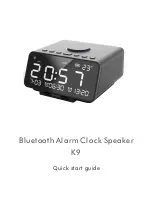
8
Snap Battery Connectors to Battery. They fit together only
one way.
Battery Missing indicator
The unit is fitted with a warning flag which pops up when
the battery is removed. This prevents the cover from closing
when there is no battery in the unit. When the battery is being
installed or changed, this flag must be held down while gently
pushing the Battery into the Battery Holder. (Figure 8).
Gently push Battery into Battery Holder
With a pencil, write the date of battery installation on the
inside of the cover to remind you when to replace the battery.
To replace the cover match up snap-in hinges and gently
press together until base and cover snap together. Test the
installed Smoke Alarm - see section 7 “Manually Testing your
Smoke Alarm (page 10)”.
NOTE: You may hear a loud chirp when attaching the Battery
Connectors to the Battery.
4.Check the radio link interconnection by holding the test
button down until the amber light has come on continuously
– this indicates that the alarm is now transmitting radio link
signals. You should now be able to hear the other alarm(s)
in the distance. If you do not hear the other alarm(s) (see
section 5.2 below).
5. The units, as received, will transmit and receive the default
RF signal. However, to avoid other neighbouring systems
interfering with your alarms, we recommend that you “house
code” your alarms.
Install all the other alarms similarly.
5.2 If RadioLink is not working
It is imperative that all smoke alarms in your system
communicate with each other. The number of walls, ceilings
and metal objects in the radio link signal path reduces the
strength of the radio link signals between the smoke alarms.
Accordingly, one or more smoke alarms may have difficulties
in communicating to all the other units in the system.
It is recommended that with systems of 3 or more alarms one
central unit is made into a Repeater Unit (see section 6 below).
If, when checking the radio link interconnection, some of the
alarms do not respond to the button test, then you will need
Figure 8






































